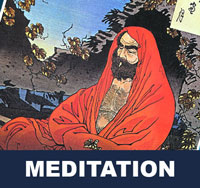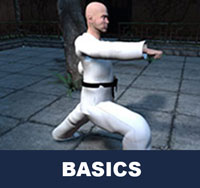Taekwondo 태권도Taekwondo Preschool
Promotion from one geup to the next can proceed rapidly in some schools, since schools often allow geup promotions every two, three, or four months. Students of geup rank learn the most basic techniques first, and then move on to more advanced techniques as they approach first dan. Many of the older and more traditional schools often take longer to allow students to test for higher ranks than newer, more contemporary schools, as they may not have the required testing intervals. View Taekwondo belt levels »

About History of Meditation
The term meditation refers to a broad variety of practices (much like the term sports) that includes techniques designed to promote relaxation, build internal energy or life force (qi, ki, prana, etc.) and develop compassion, love, patience, generosity and forgiveness.
The history of meditation is intimately bound up with the religious context within which it was practiced. Some authors have even suggested the hypothesis that the emergence of the capacity for focused attention, an element of many methods of meditation, may have contributed to the final phases of human biological evolution. Some of the earliest references to meditation are found in the Hindu Vedas. Around the 6th to 5th centuries BCE, other forms of meditation developed in Taoist China and Buddhist India.
In the west, by 20 BCE Philo of Alexandria had written on some form of "spiritual exercises" involving attention (prosoche) and concentration and by the 3rd century Plotinus had developed meditative techniques.
The Pāli Canon, which dates to 1st century BCE considers Indian Buddhist meditation as a step towards salvation. By the time Buddhism was spreading in China, the Vimalakirti Sutra which dates to 100 CE included a number of passages on meditation, clearly pointing to Zen. The Silk Road transmission of Buddhism introduced meditation to other Asian countries, and in 653 the first meditation hall was opened in Singapore. Returning from China around 1227, Dōgen wrote the instructions for Zazen.
By the 12th century, the practice of Sufism included specific meditative techniques, and its followers practiced breathing controls and the repetition of holy words. Interactions with Indians or the Sufis may have influenced the Eastern Christian meditation approach to hesychasm, but this can not be proved. Between the 10th and 14th centuries, hesychasm was developed, particularly on Mount Athos in Greece, and involves the repetition of the Jesus prayer.
Western Christian meditation contrasts with most other approaches in that it does not involve the repetition of any phrase or action and requires no specific posture. Western Christian meditation progressed from the 6th century practice of Bible reading among Benedictine monks called Lectio Divina, i.e. divine reading. Its four formal steps as a "ladder" were defined by the monk Guigo II in the 12th century with the Latin terms lectio, meditatio, oratio, and contemplatio (i.e. read, ponder, pray, contemplate). Western Christian meditation was further developed by saints such as Ignatius of Loyola and Teresa of Avila in the 16th century.
Secular forms of meditation were introduced in India in the 1950s as a Westernized form of Hindu meditative techniques and arrived in the United States and Europe in the 1960s. Rather than focusing on spiritual growth, secular meditation emphasizes stress reduction, relaxation and self-improvement. Both spiritual and secular forms of meditation have been subjects of scientific analyses. Research on meditation began in 1931, with scientific research increasing dramatically during the 1970s and 1980s. Since the beginning of the '70s more than a thousand studies of meditation in English-language have been reported. However, after 60 years of scientific study, the exact mechanism at work in meditation remains unclear.

Related Articles
Meditation is a practice in which an individual trains the mind or induces a mode of consciousness. The practice has a calming effect and directs awareness inward until pure awareness is achieved, described as being awake inside without being aware of anything except awareness itself. Meditation is often used to clear the mind and ease many health issues, such as high blood pressure, depression, and anxiety. View Meditation »
- History of Mediation - the history is intimately bound up with the religious context within which it was practiced. Around the 6th to 5th centuries BCE, other forms of meditation developed in Taoist China and Buddhist India.
- Definition of Meditation - refers to practices that includes techniques designed to promote relaxation, build internal energy or life force and develop compassion, love, patience, generosity and forgiveness. A particularly ambitious form of meditation aims at effortlessly sustained single-pointed concentration single-pointed analysis, meant to enable its practitioner to enjoy an indestructible sense of well-being while engaging in any life activity.
- Mediation Postures - various meditative postures have been used in meditation such as sitting cross-legged, sitting on a chair, and standing postures. In taekwondo, one can meditate in several stances ( 서기 sogi ) including the Back Stance ( 뒷굽이 dwi-kubi ) and the Crane Stance ( 학다리서기 hakdari-sogi ). One should feel comfortable and rest in a simple and unstrained way.
- Qigong - practice of aligning body, breath, and mind for health, meditation, and martial arts training. With roots in Chinese medicine, philosophy, and martial arts, qigong is traditionally viewed as a practice to cultivate and balance Qi (chi) or what has been translated as life energy.

Taekwondo Basics
Here is where you can learn more about Taekwondo 태권도. Knowing the fundamental basics is very important for your learning path as you build your skills and knowledge. There are certain rules that need to be followed to show respect to the master ( 사범님 sabeomnim ), the instructors ( 교사님 gyosannim ), other practitioners and to the martial arts. They vary between schools but many have similar rules and guidelines. For more information View Taekwondo Basics »
There are five tenets defined in the International Taekwondo Federation (ITF) and several more in World Taekwondo (WT).
Indomitable Spirit ( 백절불굴 baekjul-boolgool ): "To have indomitable spirit means to have the courage to stand up for what you believe in, no matter what odds you are up against, and to always give 100% effort in whatever you do." View Taekwondo Tenets »
RESOURCES
This article uses material from the Wikipedia article "Meditation", which is released under the Creative Commons Attribution-Share-Alike License 3.0.









